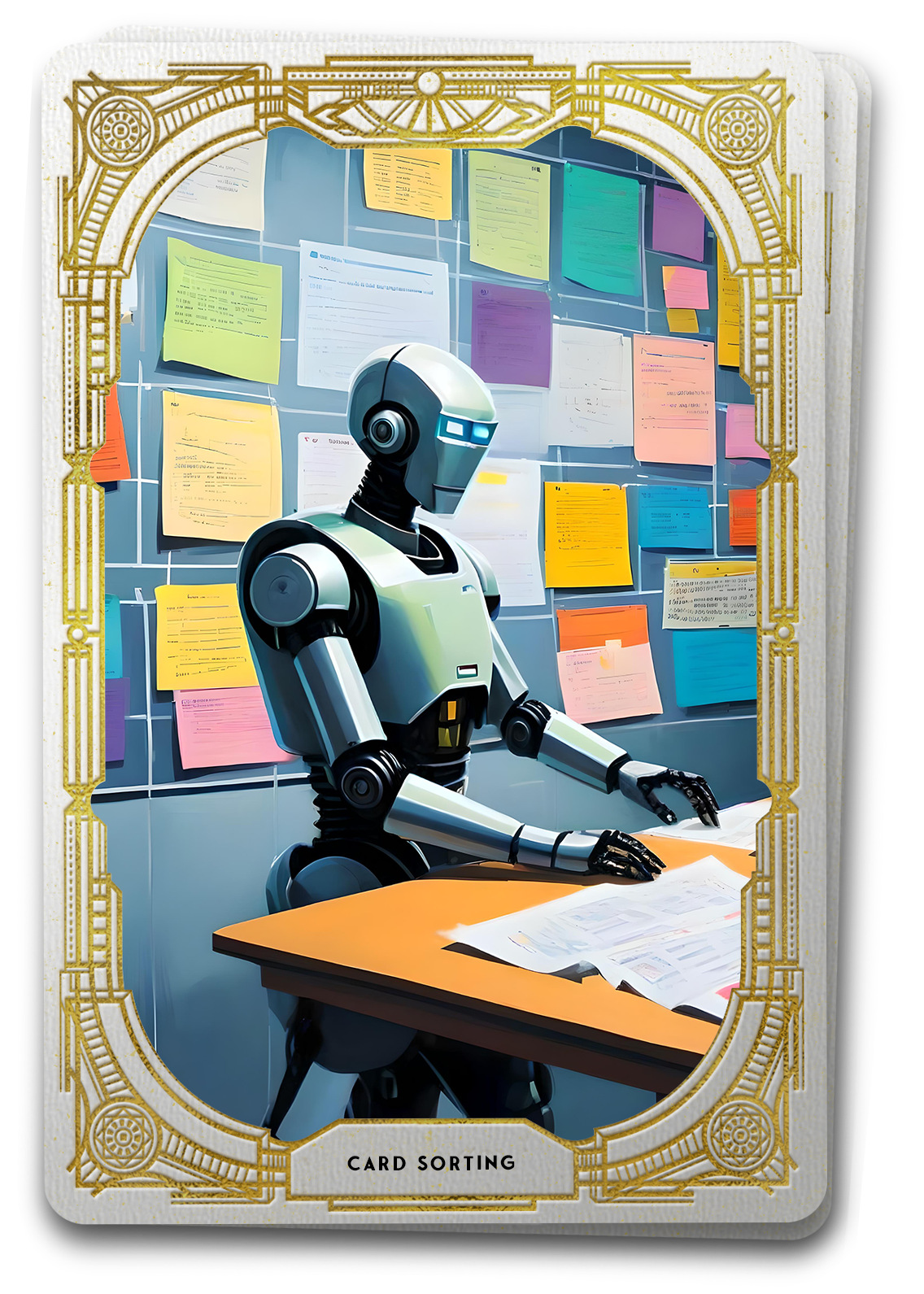
The Tarot Reveals the UX Paradox:
Sometimes you have to break the rules.
User Experience (UX) design stands as a discipline firmly grounded in principles, best practices, and established laws, all intended to foster seamless, intuitive, and satisfying user interactions with digital products. However, mastering this framework means recognizing when to ignore it — the paradox of knowing when to strategically break the conventional rules to propel user retention and engagement to new heights. By looking at some specific UX rules, psychological theories, and real-world case studies, we’ll explore the this paradox, showcasing instances where deviating from the norm becomes a strategic imperative.
Understanding the UX Paradox
The paradoxical nature of UX design involves not only recognizing when to strategically break established rules but also understanding the context in which these paradoxes can be leveraged to their fullest potential. Designers must possess a nuanced understanding of user behaviors, preferences, and the ever-evolving landscape of technology. Knowing when to introduce intentional disruptions to traditional design principles is a delicate art, often influenced by factors such as industry trends, user demographics, and the competitive landscape. Recognizing the balance between adherence to convention and the strategic implementation of paradoxes is crucial in navigating the fine line that separates innovation from confusion.
Consider the notion of controlled randomness in UI elements, where slight variations in design elements are introduced to provide a sense of unpredictability. This paradoxical approach, exemplified by Google’s homepage Doodles or dynamic loading animations, adds an element of surprise without compromising usability. By strategically breaking the rule of uniformity, these controlled random elements create a more engaging and memorable user experience. Designers can leverage this paradox when aiming to inject freshness into a familiar interface or when seeking to capture user attention in a crowded digital landscape.
And certain UX rules are particularly amenable to paradoxical design approaches. Recognizing their malleability is essential for designers seeking to push the boundaries of convention. The principle of affordance, for example, suggests that design elements should convey their functionality intuitively. However, when designing immersive virtual or augmented reality experiences, designers might deliberately blur the lines between the physical and virtual, challenging the conventional notion of clear affordances. This paradoxical approach invites users to explore and interact with digital elements more organically, fostering a sense of discovery and engagement. Understanding which UX rules are more flexible and responsive to paradoxical design allows designers to experiment and innovate while maintaining a user-centered focus.
Comprehending paradoxes in user experience design involves a nuanced understanding of when to strategically deviate from established rules, leveraging these unexpected behaviors to enhance user engagement. Recognizing the delicate balance between convention and innovation, designers can navigate the dynamic landscape of user expectations, industry trends, and technological advancements. Paradoxical examples, such as controlled randomness in UI elements, highlight the potential for enhancing user experiences through intentional disruptions. Certain UX rules, such as affordance, prove particularly receptive to paradoxical design approaches, providing designers with the flexibility to experiment while keeping user-centric principles at the forefront. Ultimately, mastering the art of the UX paradox empowers designers to craft experiences that captivate users, fostering a delicate harmony between adherence to convention and the strategic implementation of disruptive design elements.
Leveraging Psychological Theories
The strategic breaking of UX rules often finds its roots in the psychological principles that delve into the intricacies of human behavior. One such principle, the Zeigarnik Effect, illuminates the human tendency to remember uncompleted or interrupted tasks more vividly than those that have been completed. This cognitive phenomenon forms the basis for a strategic approach in user experience design, where intentionally leaving certain interactions unresolved can serve as a powerful motivator for users to return. Duolingo, a leading language-learning app, effectively incorporates this tactic by sending push notifications to remind users to complete their daily lessons. By capitalizing on the Zeigarnik Effect, Duolingo not only prompts users to return but also cultivates a habit-forming engagement, as individuals are compelled to finish what they started. This intentional deviation from the norm underscores the importance of understanding and harnessing cognitive biases to create more engaging and memorable user experiences.
Additionally, the principle of variable rewards, rooted in B.F. Skinner’s operant conditioning, plays a pivotal role in breaking traditional UX rules to enhance engagement. Variable rewards involve providing users with unpredictable, yet gratifying, outcomes for their interactions. This taps into the innate human desire for novelty and unpredictability, reinforcing behavior through intermittent positive reinforcement. Social media platforms, particularly Instagram with its variable content feed and notifications, exemplify this principle. The sporadic nature of content updates and notifications triggers curiosity and anticipation, encouraging users to frequent the platform in search of rewarding experiences. By strategically incorporating variable rewards, designers can defy the conventional wisdom of predictable and consistent experiences, creating a more captivating and habit-forming user journey.
Moreover, the mere exposure effect, a psychological phenomenon where people tend to develop a preference for things merely because they are familiar with them, offers another avenue for breaking UX rules. While consistency is often championed in design, introducing subtle variations or periodic redesigns can refresh user experiences without sacrificing usability. YouTube’s occasional interface updates, for example, leverage the mere exposure effect by introducing users to new design elements gradually. This deliberate departure from the established consistency rule not only keeps the platform visually stimulating but also capitalizes on the psychological principle that repeated exposure to change can lead to a more favorable perception over time, fostering user engagement through a sense of novelty and evolving familiarity.
In essence, the strategic application of psychological theories in breaking UX rules unveils the complexity of user behavior. By understanding and leveraging cognitive biases such as the Zeigarnik Effect, variable rewards, and the mere exposure effect, designers can craft experiences that resonate more deeply with users, fostering engagement and retention through a nuanced understanding of human psychology.
Challenging the Rule of Simplicity
While simplicity is often heralded as a cardinal rule in UX design, strategic departures from this norm can lead to groundbreaking innovations in user engagement. Take the Nike Training Club, a gamified fitness app, as a prime example of breaking the rule of simplicity to create a more dynamic user experience. Instead of adhering strictly to a minimalist interface, Nike Training Club incorporates game-like elements such as achievements, challenges, and point systems. This gamification not only adds a layer of complexity to the app but also transforms the workout experience into an immersive journey. Users are not only motivated by the pursuit of physical fitness but also by the attainment of virtual rewards and the sense of accomplishment associated with completing challenges. This intentional complexity challenges the conventional notion that simplicity is paramount, illustrating that in certain contexts, a more intricate design can result in heightened user engagement and retention.
The rule of simplicity often discourages designers from introducing elements that might be perceived as extraneous or overly intricate. However, we can look at the success of e-commerce giant Amazon to challenge this notion. Amazon, with its vast product catalog and complex recommendation algorithms, defies the conventional wisdom of simplicity in favor of comprehensive functionality. By prioritizing a sophisticated and intricate user interface, Amazon provides users with an extensive array of options and personalized recommendations, transforming the platform into a one-stop-shop for a diverse range of needs. This departure from simplicity caters to users who appreciate the wealth of choices and tailored suggestions, ultimately enhancing engagement through a more immersive and tailored shopping experience.
Looking at another example – this time from the fintech space – Robinhood presents a compelling case of breaking the rule of simplicity. Traditional investment platforms often bombard users with complex financial charts and data, potentially overwhelming novice investors. Robinhood, however, challenges this norm by simplifying the investment process, providing a clean and user-friendly interface. By streamlining the user experience, Robinhood demystifies investing for beginners, making it more accessible and less intimidating. This intentional departure from the complexity associated with traditional investment platforms has not only attracted a new demographic of users but has also revolutionized the landscape of financial technology, illustrating that breaking the rule of simplicity can be a strategic move to broaden user engagement in industries where accessibility and approachability are paramount.
Case studies like Nike Training Club, Amazon, and Robinhood showcase that, depending on the context, introducing complexity and intricacy can elevate the user experience by catering to specific user preferences and needs. By strategically breaking away from the conventional emphasis on simplicity, designers can create more tailored and immersive experiences that resonate with diverse user demographics, ultimately fostering long-term engagement and loyalty.
Embracing Unconventional Design Methods
In the pursuit of improved user engagement, designers often find value in deviating from traditional design methods, paving the way for innovation and user-centric solutions. Airbnb’s unorthodox approach to user testing serves as a remarkable case study in this domain. Instead of relying solely on conventional usability testing, Airbnb integrates live user feedback through its “Design Studio” sessions during product development. This hands-on and collaborative method not only brings designers closer to the end-users but also facilitates real-time insights and rapid iterations. By breaking away from the rigidity of traditional testing methodologies, Airbnb exemplifies the importance of adaptability and innovation in achieving a user-centric design that resonates authentically with its audience.
Additionally, unconventional design methods can manifest in approaches that prioritize emotional and experiential aspects over functional efficiency. Disney’s design philosophy, often referred to as “Imagineering,” transcends traditional boundaries by emphasizing storytelling and emotional engagement in the theme park experience. Rather than focusing solely on ride mechanics and attractions, Disney Imagineers immerse visitors in narrative-driven environments. This unconventional approach prioritizes the emotional journey of visitors, creating a more memorable and immersive experience. By integrating storytelling principles into design, Disney defies the conventional separation of emotion and functionality, showcasing that unconventional methods can lead to unparalleled user engagement.
This concept of participatory design challenges the traditional hierarchy in design processes by actively involving end-users in the decision-making and ideation phases. Open-source software projects, such as the Linux operating system, take this approach to the extreme. Within the Linux community, developers and users collaboratively contribute to the design and improvement of the software. This unconventional collaboration not only fosters a sense of community but also ensures that the end product aligns closely with user needs and preferences. By challenging the conventional notion of designers as sole authorities, participatory design empowers users to actively shape the products they engage with, fostering a more inclusive and user-centric design process.
Embracing unconventional design methods can lead to breakthroughs in user engagement and satisfaction – proving that departing from traditional approaches can open new avenues for creativity and authenticity. By integrating real-time user feedback, prioritizing emotional experiences, and involving users directly in the design process, these examples showcase the transformative potential of unconventional design methods in creating user experiences that resonate deeply and endure over time.
Utilizing the paradox of breaking UX rules to enhance user retention and engagement is the key to unveiling the dynamic nature of design. By critically evaluating established norms, drawing from psychological theories, and embracing unconventional methods, designers can strategically deviate from the constrains of design standards to create experiences that captivate and retain users. Real-world case studies underscore the efficacy of this paradox, urging designers to navigate the delicate balance between convention and innovation in the ever-evolving landscape of user experience design. Ultimately, it is through these calculated departures that the true potential of user engagement and retention is unlocked, showcasing the transformative power of intentional rule-breaking in the pursuit of exceptional user experiences.





